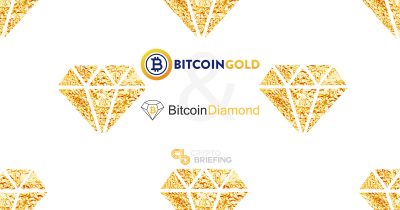What the Fork? Introduction to Bitcoin Gold and Diamond

Share this article
Because Bitcoin was all about providing access to digital currencies to the global community, it wasn’t long before the crypto community fractured. Of the thousands of cryptocurrencies on the market, many are forks of other popular blockchains.
Bitcoin’s hard forks include Bitcoin Cash, Bitcoin Gold, and Bitcoin Diamond. We’ve covered Bitcoin Cash quite a bit, due to high-visibility partnerships like DISH Network and ICO launchpad to become a Bitcoin-flavored Ethereum. It also forked itself in November 2018 to create Bitcoin SV.
Bitcoin is finally stabilizing the crypto market (today), and the altcoins created from its hard forks are showcasing the long-term sustainability options for Bitcoin as a brand. In the future, it’s possible we’ll see consolidation among blockchains and all the hard forks will consolidate under one brand. We could also see them all owned by different tech companies and blockchain giants who were able to adapt.
Or they may even become / stay decentralized.
There will always be brand recognition of Bitcoin in crypto, so let’s review the viability and performance of its Gold and Diamond forks.
Breakdown of BTG
Bitcoin Gold has a total supply of 21,000,000 BTG. Approximately $10 million worth of BTG is traded on major exchanges daily, and its peak price of $474.40 occurred on December 20, 2017.
BTG is traded on HitBTC, OKEx, Binance, Bitfinex, Huobi, Upbit, and many others. It’s typically paired with BTC, but is also tradeable for USDT, ETH, and other fiat and crypto currencies.
BTG is mined using a Equihash algorithm, which replaces the SHA-256 used by Bitcoin. This change allows graphic card GPUs to compete against ASIC mining rigs (for the time being) and decentralize mining and ownership more.
If you held BTC during the hard fork in October 2017, you received an equivalent amount of Bitcoin Gold in a 1:1 rate.
Breakdown of BCD
Bitcoin Diamond has a total supply of 210,000,000 BCD (ten times the supply of BTC and BTG). Approximately $1 million worth of BCD is traded daily on major exchanges, and its peak price of $99.19 occurred on November 255, 2017.
BCD is tradeable on Huobi, Binance, OKEx, Gate.io, and several other crypto markets, but isn’t as widely tradeable or accepted as BTC or BTG.
BCD adds Segwit and Lightning network support, larger block sizes and a similar GPU-optimized algorithm to Bitcoin Gold. It also improves on transaction security and privacy.
If you held BTC during the hard fork on November 24, 2017, you received Bitcoin Diamond at a 1:1 ratio with what you held.
Pokemon Gold and Diamond
Despite their differences, each iteration of Bitcoin is still Bitcoin. Once released in the wild, it was bound to be copied in several ways. Do these forks ride on the coattails of Bitcoin’s namesake for success? Yes.
But nobody rides coattails like Kylie Jenner, and she made the Forbes richest women list regardless. Ultimately both forks have more value than the average altcoin, and the release strategy isn’t much different than that used by Nintendo for the Pokemon games.
Generation one included Pokemon red, blue, green, and yellow. Then Gen two saw gold, silver, and crystal. Soon we were bombarded with multiple generations of expansions and releases that all ultimately fit into the Pokemon canon while satiating a public need.
Bitcoin forks (arguably) improve upon the Bitcoin formula. Consider them remixes of the original. Purists will always love the original better, but the remix can still be preferred to a lot of other songs on the radio.
Both forks have their own wallets, and the big picture of how each Bitcoin fork performs relative to the original, each other, and other altcoins will be a vital market sector to watch.
What’s the Point of the Bitcoin Forks?
Bitcoin Gold branched off from vanilla Bitcoin soon after Bitcoin Cash. It was decided (by some) that Bitcoin became too centralized because of miners and early adopters hodling large supplies. The algorithm was changed to bring mining back to what it was in Bitcoin’s heyday.
Bitcoin Diamond wanted to take things further, tweaking known faults in transaction times, fees, and late-stage coin adoption.
While neither coin can be easily spent in retail, they are easily exchangeable for Bitcoin, making them act somewhat like Bitcoin-based savings accounts. Their value will forever be tied to Bitcoin’s, but that’s not necessarily a bad thing.
Bitcoin is the most valuable crypto on the market, and it’s not likely to be shot down from the top 10 anytime in the next decade. Living in its shadow will stabilize the whole Bitcoin stable of fork coin, including the original itself.
By relieving key pain points in the core Bitcoin protocol, these forks will forever be intrinsically linked to Bitcoin was the quarters, nickels, and dimes to Bitcoin’s dollar.
Bitcoin Gold and Diamond Summary
Bitcoin forks are called out as scams and worse by purists, but they have value that will forever be linked to their father blockchain. Bitcoin Gold and Bitcoin Diamond both launched in succession after Bitcoin Cash in late 2017. They continued to build upon each other’s ideas to create unique flavors of Bitcoin that resolve vital issues.
- Bitcoin Gold and Diamond have ASIC-resistant mining algorithms to stay more decentralized easier than Bitcoin. The barrier to entry in mining is lowered to more participation.
- Bitcoin Diamond is more encrypted and secure than Bitcoin. Transactions are more private and less traceable than other networks, making it a viable privacy coin.
- Bitcoin Diamond increases the original Bitcoin block size to reduce congestion and increase scalability.
With these improvements in place, each cryptocurrency is another shot the Bitcoin brand has of surviving to become the next Amazon or Google.
